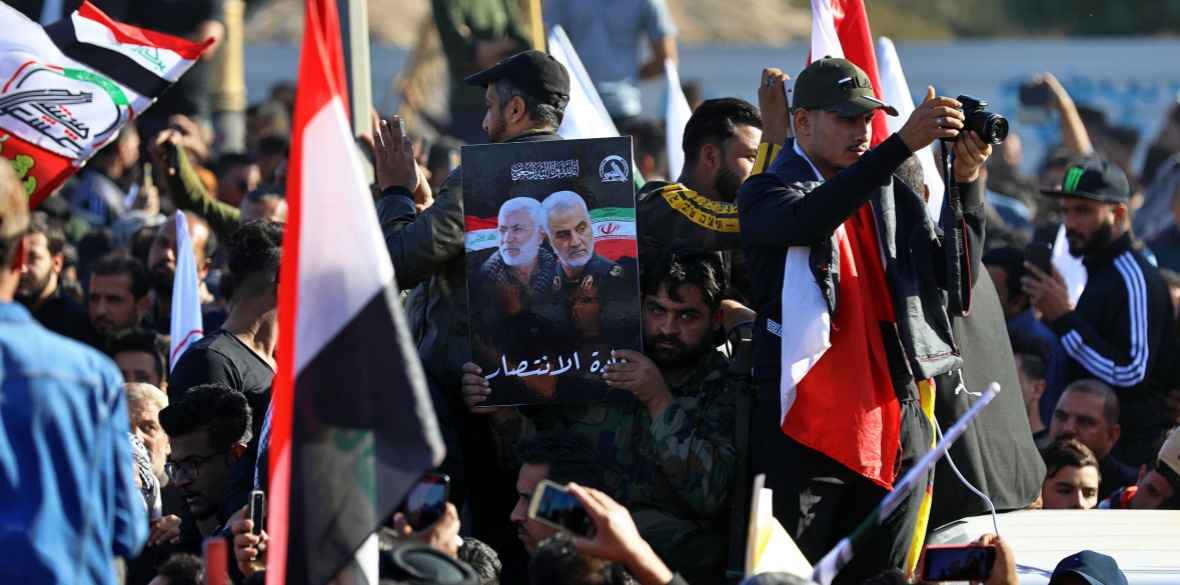This is the last article you can read this month
You can read more article this month
You can read more articles this month
Sorry your limit is up for this month
Reset on:
Please help support the Morning Star by subscribing here
“THE only way to stop Iran getting nuclear weapons is regime change in Tehran!” bayed now ex-US national security adviser, John Bolton on Voice of America, through the coarse follicles of his thick walrus moustache.
Back in 2009, all of this was just huffing and puffing. Now, however — sure as the coffin of Iranian general Qasem Suleimani moved stoically down the avenues of the Iranian capital, flanked on all sides by cries of “Death to America!” — a US war with Iran is looking ever more likely.
This would be a disaster for the US military and the Middle East. For all the chest-thumping we’ve seen from the upper echelons of the Trump administration, the idea of war with Iran — particularly a full-scale invasion — is a joke. The generals know it, the think tanks know it, moreover, the Iranians know it.
The US seems utterly complacent to the nightmare realities of war with Iran. It would saddle all belligerents with untold casualties. Here’s why…
Reason Number 1: Asymmetrical warfare in the Strait of Hormuz
Back in 2002, the US military enacted something it called The Millennium Challenge.
This was a virtual war game, set in the Persian Gulf, to test the efficacy of a sea-borne invasion of the region — much like a game of Dungeons and Dragons, only one that costs tens of millions of dollars.
There were two teams: the Blue team (the US) and the Red team (the Iranians, the bad guys).
The Red team was led by the bellicose, Strangelove-esque, retired General van Ripen.
The game, unlike war, had rules, and started with a 24-hour ultimatum to the Reds, “surrender, or we’ll attack.” What happened next, however, surprised everyone.
As the Blues sent their multitrillion-dollar fleet of aircraft carriers down the exceptionally narrow, exceptionally shallow Strait of Hormuz, they were met by hundreds of civilian pleasure vessels, dreamily circling, fishing — just as one encounters daily in the marinas of Kuwait, Qatar and Dubai.
Unable to separate potential threats from allied civilian crafts, the Blues could only fire warning shots at those who strayed too close.
Suddenly, on van Ripen’s order, a wave of rigged yachts ploughed into the vast US carriers, detonating their load on impact.
After the attack, two-thirds of the Blue fleet were destroyed, along with 20,000 servicemen lost, at the hands of just a few small ships.
The US military was decidedly annoyed at this and decided to simply declare the fleet “refloated.”
Van Ripen’s use of suicide yachts is just one of the ways in which enormous fleets of carriers (which the US navy still relies on) could be obliterated down the Strait with little expenditure on the part of Iran, via something the military calls “asymmetric warfare.”
There’s also the use of mines, which would take a lengthy and expensive US-led operation to clear, as well as ballistic missiles (we’ll get to them later) and covert operations.
Any sea-borne invasion of the country would be a veritable charge of the light brigade.
Large warships, as any submarine captain will tell you, are essentially obsolete — just giant, floating targets, incapable of dodging.
Reason Number 2: Missiles are cheap, missiles are deadly
Something the Islamic Republic of Iran excels at, and the US tend to ignore, is the employment of surface-to-surface, and surface-to-air missile systems, such as the Bavar-373, which has been described as “the most capable air defence system on the planet,” or the Sejjil-2, that has a range of over 2,000km and can’t be jammed.
Iran has amassed an immense stockpile of these ballistic missiles, and the US military doesn’t really have an answer to them. Instead, it prefers to invest in big, expensive carriers for the armada, or manned fighters for the USAF, whereas Iran, having endured the terror reaped by Iraqi surface-to-surface missiles during the Iran-Iraq war (1980-88), knows exactly how bad they can be.
Iran’s missile system can now travel thousands of miles, “threatening countries from Pakistan to Greece.”
An armada of frigates and aircraft carriers are a mere morsel to a swarm of ballistic missiles. Their advanced defence systems may be able to deal with the first wave, but certainly not the second, unless the long-expected lasers Reagan promised happen to arrive in time.
Iran knows it can’t match the US mano a mano, but, as van Ripen illustrated back in The Millennium Challenge, it doesn’t have to.
Having prepared for this a long time, they know that the US’s big, expensive gold-plated ships and carriers are its Achilles heel.
It’s all part of the US’s military hubris. It goes into a fight, as the Blue team did, expecting a tennis match, only to find their racquet broken pre-game, and its house set on fire.
Reason Number 3: Iran is a natural fortress
You may say: “Well, you don’t need to invade by sea, you can bypass the Strait of Hormuz, just invade by land, like Saddam Hussein did.”
And you’d be right. That is to say, you’d be right if it weren’t for the Elburz mountains that shelter Tehran from the Caspian Sea, or the Zagros mountains to the west, or the various Kavir and Lut desert stretches. (And that’s ignoring the nightmarish situation of basing invading troops in Iraq, with its large, and decidedly pissed-off Shia militia groups, and recent public mandate for expelling US soldiers.)
Lest we forget, in 1980, president Jimmy Carter sent a vast squad of Delta Force operatives into Iran to recapture the 52 staff members, taken hostage when revolutionaries stormed the US embassy in Tehran.
The Delta Force operatives, meticulously trained and briefed, the best of the best, didn’t even get near Tehran and “Operation Eagle Claw” became a damning public failure.
During the operation, before they’d even reached the second checkpoint, codenamed “Desert Two,” an unexpected sandstorm sent an EC-130 aircraft hurtling off course, killing eight servicemen and leading to the mission’s abandonment.
The hostages were held for 444 days in Tehran where they were tortured for information before eventually being released.
Reason Number 4: The fragile neighbour
Perhaps the most crucial ally for the US in an all-out war with Iran — certainly the most proximate one — would be Saudi Arabia, a nation with the fragility of a “moon colony.”
There are two main problems with Saudi Arabia: its reliance on oil for fuel and its reliance on desalinisation plants to provide water to its heaving, overpopulated desert cities.
The thing about oil refineries, and desalinisation plants, is that they’re both huge and easily destroyed by, say, a small deployment of surface-to-surface missiles.
With the desalinisation plants and oil refineries gone, the US, and fellow belligerents have no other option but to pin themselves down providing continuous air-drops of fuel and water to the entire Arab Peninsula — UAE, Qatar, Saudi Arabia and Kuwait — or risk them dying of thirst long before they can starve to death.
The destruction of Saudi oil fields also brings other players into the picture. The US might be able to rely, at least for a short time, on North American shale, but recently industrialised nations such as China and India cannot.
What happens after China gets involved, and the conflict escalates, or rather spirals out of control?
Reason Number 5: The proxies
During the Iran–Iraq war of the 1980s, there was a lot of talk about minority ethnic groups rising up against the central Shi’ite theocracy — but this didn’t happen.
Instead, and much to the chagrin of CIA insurgency groups, the Iranians remained relatively untouched by the various potential proxy clans, who instead began to coalesce against the foreign invader.
Iran’s proxies, on the other hand, are on a notable winning streak. They have a relationship with the Lebanese militant group Hezbollah that far surpasses financial loyalty — a relationship that has terrified and frustrated numerous Mossad and IDF commanders over the years.
Iran also harbours strong connections to Houthi rebels in Yemen, who’ve held Saudi Arabia at bay for years now, even with their use of made-in-America fighter jets and frigates.
And then there’s the Kurdish militias, which almost certainly won’t be as quick to aid the US — as they did, bravely, in the fight against Isis — after Trump essentially betrayed them last year; withdrawing US troops, and leaving them to fend off Erdogan’s carpet bombs and vast armoured divisions alone.
The Kurds and Iran have also fought a common enemy before, Saddam’s Ba’ath Party, which was responsible for loosing a chemical weapons attack on the Kurdish city of Halabja during the closing days of the Iran-Iraq war, an event known to many as “Bloody Friday.”
Reason Number 6: Isis!
Speaking of proxies and pariah states — who benefits from widespread chaos throughout Iran, Iraq and the Levant?
Who benefits from the major Shi’ite player in the region pinned down by the richest nation in the world?
Who benefits from small, roving bands Sunni militia groups, or volatile stateless regions, or vast sums of money allocated for any Sunni wallet willing to destabilise the area?
The answer should be fairly obvious, and the US should be well aware of the concern. Particularly after it allowed for the escape of over a hundred Isis prisoners back in October.
Isis came out of the vacuum left by the Syrian civil war, a conflict that should pale in comparison to the bloodbath of a potential US–Iran showdown.
Whether Washington and Langley would be cynical enough to risk funding the group is another question, the optics certainly wouldn’t be good, but I wouldn’t put past the administration. The US has, after all, backed just as bloodthirsty players in El Salvador and Nicaragua.
Which brings me to my final, and perhaps most pertinent reason against US war with Iran…
Reason Number 7: The president of US has a mushy brain
It is a truth, self-evident, that Donald Trump has neither the patience, nor the strategic aptitude needed to co-ordinate what might very easily amount to World War III.
His tiny fingers would grope towards the nuclear football faster than you could tweet a shoddily rendered US flag (or maybe they wouldn’t, who the hell knows!? And that’s my point…)
Both Cheney and Obama (in his own creepy way), had the composure and procedural planning capabilities needed to pull off large-scale, destabilisation campaigns.
And, whether you liked them or not, you vaguely knew where they stood. Trump, however, is impossible to predict.
He has no real values other than retaining popularity amongst his cheerleaders and is entirely resistant, if not openly antagonistic, to the process of learning new information, a essential trait for a wartime leader.
If anyone is capable of open warfare with Iran (and I’m not sure anyone is), that person is not Donald Trump, who receives his memos on colourful post-it notes, and fast forwards through action films to get to the gore.
Summarily…
War with Iran is a joke, an invasion of Iran is more than a joke, it’s suicide, and if the current US administration doesn’t de-escalate soon, than the resultant fires could spread, unquenchable, across the region and the world.
Perhaps the US will bring back the draft? And, like the Vietnam war, we’ll all look on in horror as hundreds of thousands of innocent lives are lost, but for the pretensions of a few old men in a silly-shaped room.











